By Lacie Armstrong
Lots of controversial questions are fluttering around urban agriculture and vertical farming. These questions include; marks on efficiency, availability, usefulness, prices, viability and demand for food. With that being said, in the US alone, the vertical farming market is projected to reach values of around $3 billion by 2024. Globally, the predicted value is $6.4 billion by 2023, with both figures growing at a similar rate of 24% CAGR. More indoor agriculture-specific technology is coming to shake the industry.
Why Indoor Farming Looks Great
Vertical farming’s value propositions include; a controlled environment, less water use, no pesticides, controlled fertilizer use, easier automation, optimized growing conditions, food safety and high-density output that can be placed in or near urban demand.
With agriculture moving towards supporting another 3.25 billion people in urban environments over the next thirty years, the high volume of investment in this sector is understandable. In order to support the investment required these farms have focused on greens and herbs and the ability to provide a consistent and predictable volume of produce all year round.
With these large volumes of produce, there needs to be food safety. Vertical Farming prevents food born illness which is estimated to cost the US economy $15.6 billion per year. Vertical farms are controlled growing environments, and dirt-free, therefore no washing is required.
Reduced water use is also important in markets such as EMEA where this is a more expensive input or in areas with often restricted supply but large demand such as California.
Breaking Down The Technologies
There are three technologies used in vertical farming; hydroponics, aeroponics, and aquaponics.
- Hydroponics is the most popular method, accounting for around 70% of installed capacity, as it is the least expensive system to build, and the water substrate system is easiest to control.
- Aeroponics is next, with a nutrient-rich mist substrate that feeds plants. It is generally a more expensive system to install, but water use is 40% lower than hydroponics and 95% lower than field farming. Leading installers include AeroFarms and Living Greens.
- Aquaponics incorporates fish farming into the hydroponic substrate to take advantage of natural feeding and waste cycles to produce nutrients for the crops. Leaders in aquaponics include BIGH and Superior fresh.
Types Of Investors And Their Business Models
There are the agriculture and food-focused investors, such as Wheatsheaf Investments (AeroFarms) or Finistere Ventures (Plenty/Bio Lumic), but the majority are generalists, and there is a noticeable lack of food and agricultural industry incumbents. No large agricultural OEM such as a John Deere, CNH, AGCO, or others, have placed a bet in vertical farming. However, IKEA, a food, logistics, and homewares company, has invested in Click & Grow and AeroFarms’ latest round, giving an insight into where food will be grown and who will be growing it in the future. We expect to see more agricultural corporate direct interest into these companies in the coming year.
Questions Awaiting Answers
In order to answer the question of long-term viability, we will need to keep watch with the market’s future response to the following questions:
- Will vertical farms stay focused on niche produce and markets?
- Do they compete against rooftop farms that have lower energy costs and provide a wider range of produce?
- Will they compete against greenhouse farms that benefit from cheaper real estate, but must ship produce long distances to the urban markets and have higher costs of automation?







